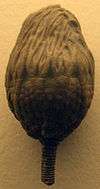Sagenocrinites
| Sagenocrinites Temporal range: Silurian | |
|---|---|
 | |
| Sagenocrinites expansus (Phillips), on display at the Natural History Museum | |
| Scientific classification | |
| Kingdom: | Animalia |
| Phylum: | Echinodermata |
| Subphylum: | Crinozoa |
| Class: | Crinoidea |
| Order: | Sagenocrinida |
| Genus: | Sagenocrinites |
Sagenocrinites is an extinct genus of crinoid from the Silurian period. During the Silurian period, a sea-covered Britain that was shallower in the south and deeper in the north lay south of the equator with a tropical to sub-tropical climate. Therefore, in the United Kingdom, amongst Silurian fossils, such as brachiopods, trilobites and graptolites, coral-like organisms like sagenocrinites can be found.
Because this species belongs to a genre of crinoids which is very sensitive concerning the environmental influences their petrified remains can therefore be viewed as indicators of the climate conditions. By using a geological world map, these fossils will help to create a complex climate model, tracing back more than 400 million years to the ancient Earth. With a high accuracy it will be possible to reconstruct the climate history of our planet.
Sources
- Fossils (Smithsonian Handbooks) by David Ward (Page 168)
- "Fossil Field Guide" by Peter Sheldon, chapter 27